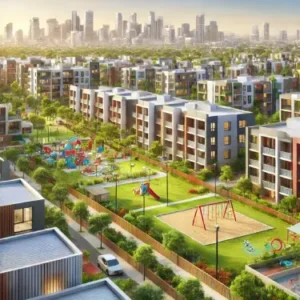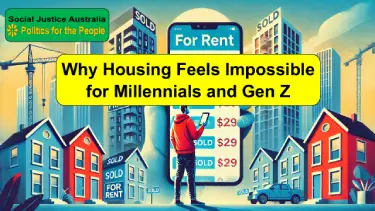Description:
Discover why housing is so expensive and how public funding can build affordable homes for Millennials and Gen Z in Australia.
Introduction
The dream of homeownership is slipping away for Millennials and Gen Z. Over the past few decades, housing costs have skyrocketed, leaving many stuck in a perpetual cycle of renting with little hope of financial stability. Public funding for affordable housing could be the solution to this crisis, but systemic issues stand in the way.
In this article, we explore the root causes of the housing crisis, its impact on younger generations, and successful public housing models that could offer a path forward.
The Root Causes of the Housing Crisis
Decades of Poor Housing Policy
Australia’s housing landscape has shifted dramatically since the 1980s. Once, public housing programs provided affordable homes for working-class families. Today, the focus has moved toward market-driven solutions that favour private developers over public needs.
Key policies, like reduced public housing investment and reliance on the private sector, have created an affordability gap. The prioritisation of market profitability has left millions priced out of homeownership.
The Influence of Speculation and Investors
Investor-driven demand has turned housing into a commodity rather than a necessity. Tax incentives like negative gearing and capital gains tax discounts encourage speculation, driving up prices.
In 2023, investor-owned properties accounted for 29% of all Australian homes, a significant contributor to the affordability crisis.
Wage Stagnation vs. Housing Costs
Millennials and Gen Z face an uphill battle due to stagnant wages. Between 2013 and 2023, real wages in Australia rose by just 0.2%, while housing prices surged by 90%. Change in house prices. The widening gap between income and housing costs leaves younger Australians locked out of the market.
How This Crisis Impacts Millennials and Gen Z
Renting for Life
The average Australian renter now spends 30–40% of their income on housing, often sacrificing savings for essentials like health care and education.
A 2022 survey found that 67% of Millennials believe they will never own a home, a stark contrast to earlier generations who saw homeownership as achievable by their mid-30s.
The Mental Health Toll
Unaffordable housing takes a toll on mental well-being. Chronic stress, anxiety, and feelings of hopelessness are common among younger generations unable to secure stable housing. This crisis has broader societal implications, including lower birth rates and declining economic productivity.
The Generational Wealth Gap
Homeownership is a key driver of wealth accumulation. Without it, Millennials and Gen Z risk falling behind financially, perpetuating generational inequality.
Case Studies: Public Housing Success Stories
Australia’s Forgotten Success
After World War II, the Australian government built tens of thousands of affordable public homes, providing quality housing for working families. This approach reduced inequality and stimulated economic growth.
However, the neoliberal policies of the 1980s dismantled these programs, leaving a void in affordable housing development.
Lessons from Sustainable Housing Projects
Sustainability is a growing trend in public housing. Initiatives like the Nightingale Housing project in Melbourne shows how eco-friendly designs can lower costs and improve quality of life. Ref: YouTube Video.
Why Public Funding Is the Solution
The Case for Public Money Over Private Profit
Private developers prioritise profits, often at the expense of affordability. Public funding allows governments to focus on building homes that meet societal needs rather than investor demands.
Using Australia’s monetary sovereignty, the government could finance large-scale public housing projects without burdening taxpayers (reference).
Public Housing as an Economic Stimulus

Investing in public housing not only addresses affordability but also creates jobs in construction and urban development. These projects stimulate the economy while ensuring long-term societal benefits, such as reduced homelessness and better community health outcomes.
Call to Action for Millennials and Gen Z
Advocate for Policy Changes
 Millennials and Gen Z have the power to demand housing reforms.
Millennials and Gen Z have the power to demand housing reforms.
– Vote for candidates who prioritise affordable housing.
– Support policies like the removal of negative gearing and increased public housing funding.
– Vote wisely and vote strategically.
Push for Sustainable Public Housing
Sustainable public housing addresses two of the most pressing challenges facing Australians today: housing affordability and environmental sustainability. By prioritizing government-funded and built public housing projects, we can tackle the housing crisis while reducing the environmental impact of residential construction. Here’s a deeper dive into the issue and its potential solutions:
1. Understanding the Housing Crisis
– Rising Rents and Mortgage Stress: Many Australians, especially younger generations, are locked out of home ownership and struggle to keep up with soaring rents.
– Shortage of Affordable Housing: Decades of reliance on private developers have led to a severe shortage of homes accessible to low- and middle-income families.
– Impact on Vulnerable Populations: People with disabilities, single-parent families, and those on lower incomes are disproportionately affected, with many at risk of homelessness.
2. The Case for Public Housing
– Guaranteed Affordability: Public housing provides secure, long-term rental options with rates capped at an affordable percentage of income.
– Economic Stability: Unlike market-based solutions, public housing ensures people have stable homes, enabling them to focus on work, education, and health without constant financial stress.
3. Incorporating Sustainability
– Energy-Efficient Designs: Modern public housing projects can incorporate solar panels, passive cooling systems, and energy-efficient appliances to reduce costs and carbon footprints.
– Sustainable Materials: Using locally sourced, renewable, or recycled materials can minimize the environmental impact of construction.
– Green Spaces: Incorporating communal gardens, trees, and parks into public housing developments promotes mental well-being and biodiversity.
4. Successful Examples Worldwide
International Examples
Vienna, Austria
Over 60% of Vienna’s population lives in affordable public housing. Long-term investment in community-oriented housing has kept rents low and quality high.
Key takeaway: Government prioritisation of housing as a public good creates stability.
Singapore
Singapore’s Housing Development Board (HDB) provides 80% of the population with affordable homes. The government’s direct involvement ensures that housing stays accessible to all citizens.
Key takeaway: Robust public investment leads to universal access to quality housing.
5. Economic and Social Benefits
– Job Creation: Public housing projects create employment opportunities in construction, maintenance, and renewable energy sectors.
– Reduced Welfare Costs: Stable housing decreases reliance on emergency welfare services, saving public money in the long term.
– Community Building: Sustainable developments encourage inclusive, connected communities where people thrive.
6. Overcoming Opposition
– Addressing Myths: Some argue public housing is costly or leads to poorly maintained properties. However, well-managed projects worldwide demonstrate that public housing can be both economically viable and high quality.
– Shifting Funding Priorities: Reallocating public money from subsidies for private developers to directly funding public housing projects ensures accountability and better results.
7. Policy Recommendations
– Direct Public Investment: Governments should directly fund the construction of public housing rather than relying on private-public partnerships that prioritize profits.
– Long-Term Planning: Establish a national public housing strategy with clear targets for sustainability and affordability.
– Incentives for Green Building: Offer grants or tax benefits for integrating renewable energy and sustainable practices into housing projects.
Call to Action:
Investing in sustainable public housing is not just about shelter; it’s about creating a fairer, greener Australia. Let’s push our leaders to prioritize public housing that meets the needs of the present without compromising future generations. If you agree, share this article and join the conversation on social media using #SustainableHousingAU!
What innovative ideas do you have for sustainable public housing in Australia? Comment below!
Unite for Collective Action
Grassroots movements like “Everybody’s Home” highlight the power of collective action in influencing policy changes. Millennials and Gen Z must unite to amplify their voices and demand a fairer housing system.
Conclusion
The housing crisis is not an insurmountable challenge. By addressing the root causes, learning from international examples, and using Australia’s monetary sovereignty, Millennials and Gen Z can help reshape the housing landscape. The solution lies in public funding, sustainable design, and collective action.
Thought-Provoking Question
What steps do you believe Millennials and Gen Z should take to make affordable housing a reality?
Call to Action
If you found this article insightful, explore more about political reform and Australia’s monetary sovereignty on Social Justice in Australia: https://socialjusticeaustralia.com.au/.
Share this article with your community to help drive the conversation toward a more just and equal society.
Click on our “Reader Feedback” menu. Let us know how our content has inspired you. Submit your testimonial and help shape the conversation today!
Additionally, leave a comment about this article below.
Support Our Mission
If you believe in holding corporations accountable and creating a more just society, consider supporting our work. Your donations help us continue producing in-depth, informative content and advocating for meaningful reforms. Every contribution, big or small, makes a difference.
Donate Here to help drive positive change.
Thank you for standing with us for a fairer, more equitable Australia.

